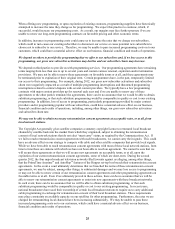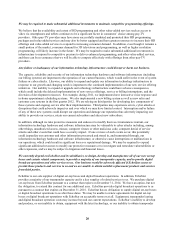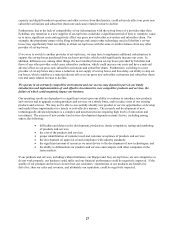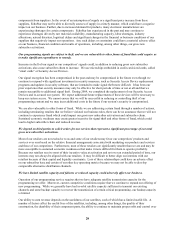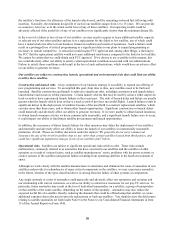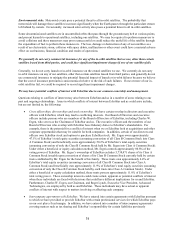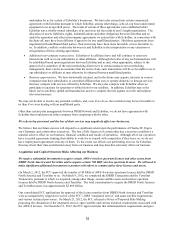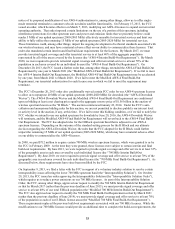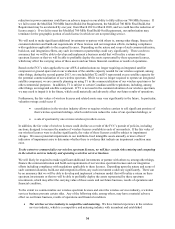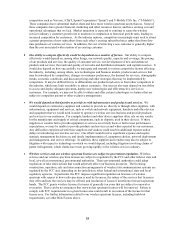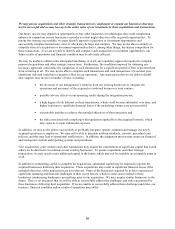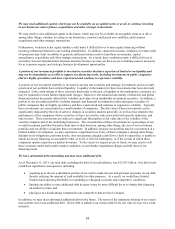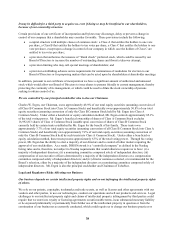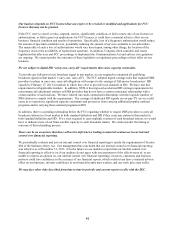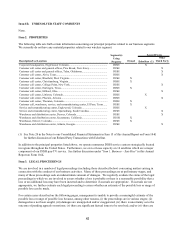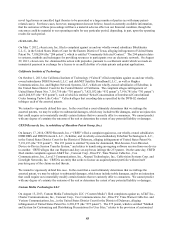Dish Network 2013 Annual Report Download - page 44
Download and view the complete annual report
Please find page 44 of the 2013 Dish Network annual report below. You can navigate through the pages in the report by either clicking on the pages listed below, or by using the keyword search tool below to find specific information within the annual report.34
34
reduction in power emissions could have an adverse impact on our ability to fully utilize our 700 MHz licenses. If
we fail to meet the Modified 700 MHz Interim Build-Out Requirement, the Modified 700 MHz Final Build-Out
Requirement may be accelerated by one year, from March 2021 to March 2020, and we could face the reduction of
license area(s). If we fail to meet the Modified 700 MHz Final Build-Out Requirement, our authorization may
terminate for the geographic portion of each license in which we are not providing service.
We will need to make significant additional investments or partner with others to, among other things, finance the
commercialization and build-out requirements of these licenses and our integration efforts, including compliance
with regulations applicable to the acquired licenses. Depending on the nature and scope of such commercialization,
build-out, and integration efforts, any such investment or partnership could vary significantly. There can be no
assurance that we will be able to develop and implement a business model that will realize a return on these
spectrum licenses or that we will be able to profitably deploy the assets represented by these spectrum licenses,
which may affect the carrying value of these assets and our future financial condition or results of operations.
Based on the FCC’s rules applicable to our AWS-4 authorizations no longer requiring an integrated satellite
component or ground spare and on our evaluation of the satellite capacity needed for our wireless segment, among
other things, during the second quarter 2013, we concluded that T2 and D1 represented excess satellite capacity for
the potential commercialization of our wireless spectrum. While we are no longer required to operate an integrated
satellite component, we are currently planning on using T1 in the commercialization of our wireless spectrum or for
other commercial purposes. In addition, T1 is subject to certain Canadian satellite regulations, including, among
other things, an integrated satellite component. If T1 is not used in the commercialization of our wireless spectrum,
we may need to impair it in the future, which could materially and adversely affect our future results of operations.
Furthermore, the fair values of wireless licenses and related assets may vary significantly in the future. In particular,
valuation swings could occur if:
x consolidation in the wireless industry allows or requires wireless carriers to sell significant portions of
their wireless spectrum holdings, which could in turn reduce the value of our spectrum holdings; or
x a sale of spectrum by one or more wireless providers occurs.
In addition, the fair value of wireless licenses could decline as a result of the FCC’s pursuit of policies, including
auctions, designed to increase the number of wireless licenses available in each of our markets. If the fair value of
our wireless licenses were to decline significantly, the value of these licenses could be subject to impairment
charges. We assess potential impairments to our indefinite-lived intangible assets annually or more often if
indicators of impairment arise to determine whether there is evidence that indicate an impairment condition may
exist.
To the extent we commercialize our wireless spectrum licenses, we will face certain risks entering and competing
in the wireless services industry and operating a wireless services business.
We will likely be required to make significant additional investments or partner with others to, among other things,
finance the commercialization and build-out requirements of our wireless spectrum licenses and our integration
efforts including compliance with regulations applicable to these licenses. Depending upon the nature and scope of
such commercialization, build-out and integration efforts, any such investment could vary significantly. There can
be no assurance that we will be able to develop and implement a business model that will realize a return on these
spectrum investments or that we will be able to profitably deploy the assets represented by these spectrum
investments, which may affect the carrying value of these assets and our future business, results of operations and
financial condition.
To the extent we commercialize our wireless spectrum licenses and enter the wireless services industry, a wireless
services business presents certain risks. Any of the following risks, among others, may have a material adverse
effect on our future business, results of operations and financial condition.
x The wireless services industry is competitive and maturing. We have limited experience in the wireless
services industry, which is a competitive and maturing industry with incumbent and established



